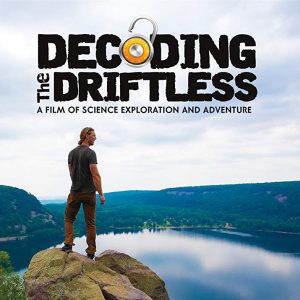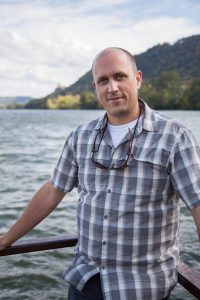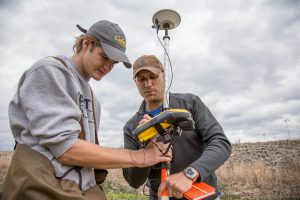You don’t need to talk for very long to Dr. Dylan Blumentritt, Assistant Professor in the Geoscience department at Winona State University, to know that he is passionate about his work. His eyes gleam with excitement as he explains the beauty of the Driftless Area, a Midwest region that possesses unique geographical and archaeological features due to the absence of glacial erosion during the last Ice Age.
Blumentritt remembers spending a lot of time outdoors as a child, playing among the streams and bluffs in Winona County, in the heart of the Driftless Area. He suspects this played a significant role in the trajectory of his career path, as he discovered early on he had a passion for studying the rocks and waters of southeastern Minnesota.
After earning a bachelor’s degree in Geology at Gustavus Adolphus, Blumentritt went on to earn a master’s degree in Geology and a Ph.D. in Earth Sciences at the University of Minnesota. He served as an adjunct faculty member at the University of St. Thomas and as an Assistant Professor at SUNY Potsdam before joining the faculty at Winona State in 2016. Blumentritt now spends his time sharing his fascination with the Driftless Area with WSU undergraduate students right where it all first began.
“There are certain moments where you can see a spark, when something resonates with a student,” he describes. “I really enjoy seeing those who come in and are unsure about becoming a geologist, but then thriving and succeeding and going out and doing great things.”
Blumentritt also uses his research work to give back to the Driftless Area, undertaking study and analysis intended to preserve and protect this special landscape for future generations. He is currently pursuing research on water quality with faculty and students in the WSU Biology and Chemistry departments, as well as a research project on landslide hazards in collaboration with the US Geological Survey, the Freshwater Institute, and seven partner universities.
“We’re really lucky at Winona State,” observes Blumentritt. “There’s a lot of value placed on student-faculty research here, and the university invests in creating space for us to conduct different kinds of research. Upgraded labs, the latest tools and technology—it all comes together to support high-caliber research and student engagement.”
But even more importantly, he adds, WSU creates an inclusive learning environment in which both students and faculty thrive.
“The faculty here all really care about the students and go the extra mile in making sure our students are successful,” Blumentritt says. “I think, too, the students really come together as an extended family. It’s not a competition. They bring each other up so they all can succeed.”
Blumentritt’s reputation and expertise in the Driftless Area recently led to a unique opportunity to be part of an adventure documentary called Decoding the Driftless, produced by Emmy Award-winning filmmaker and WSU alumnus George Howe ’83.
Howe grew up just down the river from Winona in La Crescent, Minn., and like Blumentritt, he grew up fascinated by the local geology and environmental elements of the Driftless Area. He studied Biology: Environmental Science and Chemistry at Winona State, and went on to share his knowledge in many ways, including as a research biologist, a water scientist, and teaching Biology.
 “I believe knowledge is foundational to everything,” Howe explains. “If you know about the land, then you can care about it, and do the right thing, conservation-wise.”
“I believe knowledge is foundational to everything,” Howe explains. “If you know about the land, then you can care about it, and do the right thing, conservation-wise.”
In 2013, Howe collaborated with fellow producers and nature-lovers Tim Jacobson and Rob Nelson to release Mysteries of the Driftless, a short film addressing the diverse natural and archeological resources, unique historical geology, and conservation success stories of the Driftless Area. The film had immense success and earned a regional Emmy for top documentary in the Midwest.
The success of Mysteries of the Driftless spurred a desire to create a new feature-length film, Howe says, one that would dive deeper into the unique geology, ecology, archaeology and local communities of the Driftless Area. Enter Decoding the Driftless, and the calls Howe placed to Blumentritt and other professors and researchers from around the region.
The world premiere of Decoding the Driftless took place in fall 2018 in La Crosse, Wis., in front of a standing-room-only audience in an auditorium with seating for 1,100 people. It went on to win two awards, including Best Picture, at the Los Angeles Independent Film Festival in February 2019, and was recently invited to the International Environmental Film Festival in Melbourne, Australia.
Like Mysteries of the Driftless before it, Decoding the Driftless was screened on the Winona State campus as part of the 2019 Frozen River Film Festival, just steps away from where Blumentritt teaches his classes and seeks to inspire the next generation of students to share in the wonder of the Driftless Area.
“I knew immediately that I wanted to get involved (in this film),” says Blumentritt. “I think bringing attention to this area and the natural surroundings, explaining the local geology, and telling people what’s really cool about this area—it’s what I’m all about in my teaching.”


